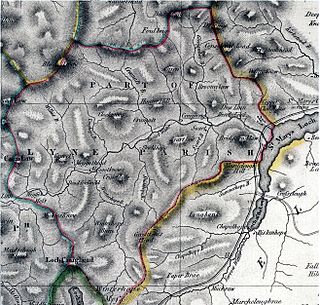The Bishop of Aberdeen was the ecclesiastical head of the Diocese of Aberdeen, one of Scotland's 13 medieval bishoprics, whose first recorded bishop is an early 12th-century cleric named Nechtan. It appears that the episcopal seat had previously been at Mortlach (Mòrthlach), but was moved to Aberdeen during the reign of King David I of Scotland. The names of three bishops of Mortlach are known, the latter two of whom, "Donercius" and "Cormauch" (Cormac), by name only. The Bishop of Aberdeen broke communion with the Roman Catholic Church after the Scottish Reformation. Following the Revolution of 1688, the office was abolished in the Church of Scotland, but continued in the Scottish Episcopal Church. A Roman Catholic diocese was recreated in Aberdeen in 1878.
Alexander Gordon was a 16th-century Scottish churchman who was successively archbishop of Glasgow, titular archbishop of Athens, bishop of the Isles and bishop of Galloway.
Gilbert Rule was a nonconformist Church of Scotland minister and the Principal of Edinburgh University from 1690 to 1701.
John Douglas was Archbishop of St. Andrews from 1572 to 1574. As was tradition from the fifteenth to the seventeenth centuries, the Archbishop would take on the role of Chancellor of the University of St Andrews, as the University had strong links with the Pre-Reformation church.
James Hay O. Cist. was a Cistercian abbot and bishop important in the early 16th century Kingdom of Scotland. At some stage in his life he achieved a doctorate in decrees, enabling him to be styled D. D..
John Spalding was a 15th-century churchman based at Brechin in Angus, Scotland. Spalding became Dean of Brechin in 1456; he was confirmed in this position by the Pope on 5 October 1458.

John Strang (1584–1654) was a Scottish minister and Principal of Glasgow University.

Spott is a small village on the eastern fringes of East Lothian in Scotland, just over 2 miles (3.2 km) south-west of Dunbar. The village straddles an unclassified road leading from the main A1 highway at grid reference NT673755.

Chirnside Parish Church is a kirk of the Church of Scotland. It is situated on the B6355 road between Duns and Eyemouth in the old county of Berwickshire, now part of the Scottish Borders, at grid reference NT869560. The town of Chirnside is 6 miles (9.7 km) east of Duns, and 9 miles (14 km) north-west of Berwick-upon-Tweed.

Ayton and Burnmouth Parish Church is a member church of the Church of Scotland, serving the communities of Ayton and Burnmouth in the Scottish Borders. The church is situated on the side of the B6355 road, just off the main A1 road, 0.5 miles (0.80 km) south of the village centre and 6.5 miles (10.5 km) north-west of Berwick upon Tweed, at grid reference NT927609.

Lady Yester's Kirk was a congregation of the Church of Scotland. The building is located on Infirmary Street in Edinburgh, Scotland, and was formerly one of the foremost churches in the burgh. It is now used as the joinery workshop for the Estates Division of the University of Edinburgh.
Neil Campbell, M.A. was a Scottish clergyman who served in the Church of Scotland as the Bishop of the Isles from 1633 to 1638.

Megget is a former chapelry or parish containing the valley of Megget Water, now forming the westernmost part of the parish of Yarrow, Selkirkshire in the Scottish Borders area of Scotland. The centre of the valley is 19 miles west of Selkirk.

James Julius Wood (1800–1877) was a 19th-century Scottish minister who served as Moderator of the General Assembly of the Free Church of Scotland 1857/8.
James Montgomery Campbell (1859-1937) was a Scottish clergyman who served as Moderator of the General Assembly of the Church of Scotland in 1928.
Archibald Fleming TD Order of St Sava (1863–c.1930) was a Scottish minister, military chaplain and religious author. He was Grand Chaplain to the Grand Lodge of Freemasons in Scotland.
Angus McBean, or as he was otherwise known by his family Æneas McBean was a Scottish minister and Covenanter. He was the last Presbyterian minister deposed under Episcopacy.

Rev James Campbell (1789-1861), born in Carsphairn, Kirkcudbrightshire to William Campbell and Agnes, née Riggs, was a Scottish clergyman and established Church of Scotland parish minister of Traquair in Peeblesshire.
Thomas Taylor (c.1770–1831) was a 19th century Church of Scotland minister, who served as Moderator of the General Assembly in 1826.
Andrew Hay of Renfield (c.1540–1593) was a Scottish minister who served twice as Moderator of the General Assembly of the Church of Scotland in both 1573/4 and 1580/1. From 1569 to 1586 he was also Rector of the University of Glasgow.









